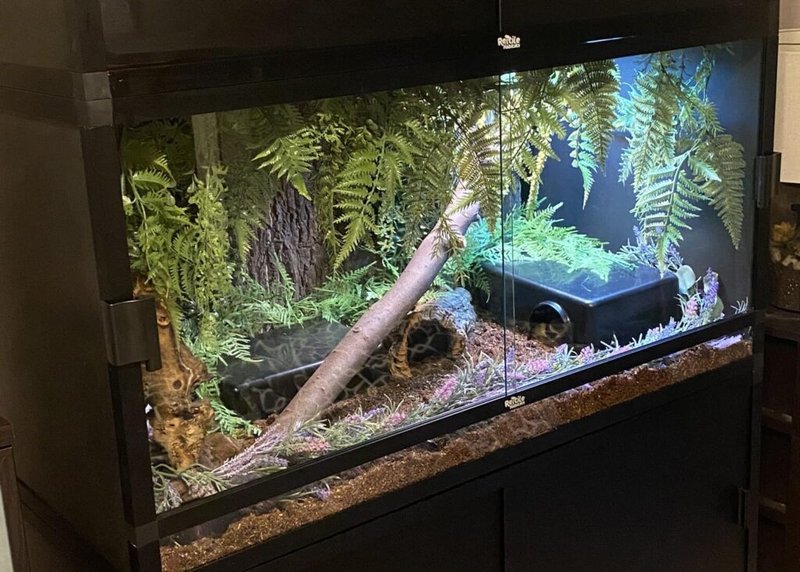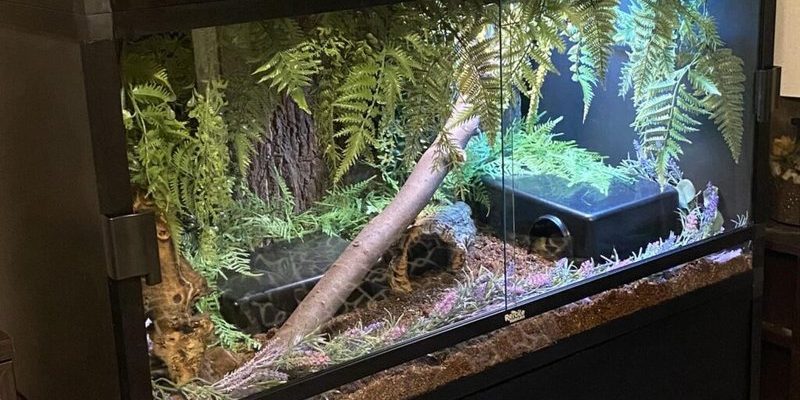
You might be wondering, “What’s the best size for an enclosure?” or “How can I ensure the temperature is just right?” Let me explain. The right enclosure not only provides comfort but also supports your snake’s health, allowing them to bask, hide, and roam as they would in the wild. So grab a cup of coffee, and let’s dive into the nitty-gritty of creating the ideal ball python setup.
Choosing the Right Size Enclosure
The size of your ball python’s enclosure is crucial. Generally, a 40-gallon tank is recommended for an adult ball python. This gives them enough space to stretch out and explore while still feeling safe. But if you have a hatchling, you might start with a 20-gallon setup and upgrade as they grow.
Why the difference in size? Think of it like this: a cozy studio apartment might work for a single person, but as they grow, they might need a bigger space. Similarly, younger ball pythons feel more secure in smaller enclosures, while adults benefit from a larger habitat to explore.
Here’s a quick overview of enclosure sizes by age:
| Age | Recommended Size |
| Hatchling (0-6 months) | 10-20 gallons |
| Juvenile (6 months – 2 years) | 20-40 gallons |
| Adult (2+ years) | 40-75 gallons |
You might be thinking, “Is bigger always better?” Not really. A too-large enclosure can make them feel insecure, while a too-small one can stress them out. Aim for a balance that promotes happiness and health.
Heating Your Ball Python’s Enclosure
Here’s the thing: ball pythons are ectothermic, meaning they rely on external heat sources to regulate their body temperature. This makes proper heating vital in their habitat. Typically, you need to create a temperature gradient within the enclosure, which mimics their natural environment.
On one end of the tank (the warm side), aim for a temperature of about 88°F to 92°F. This is where your snake will bask to regulate its body temperature. On the cooler side, you should maintain around 75°F to 80°F. This gradient allows your python to choose its comfort zone, much like how you’d choose a comfy spot on a sunny day.
To achieve this, you can use heat mats, basking bulbs, or even ceramic heat emitters. Here’s a quick rundown of each:
- Heat Mats: Placed under the tank, they provide steady heat. Just make sure to monitor the temperature.
- Basking Bulbs: These provide direct heat and light but should be used cautiously to avoid overheating.
- Ceramic Heat Emitters: They emit heat without light, ideal for nighttime use.
Always keep an eye on the temperatures using a good thermometer, as maintaining the right heat levels can prevent health issues.
Choosing the Right Substrate
The substrate in your ball python’s enclosure serves multiple purposes, from providing a comfortable surface to aiding in digestion. Here’s where you get to be a little creative with your setup!
Common choices for substrates include aspen shavings, coconut coir, and reptile carpet. Each has its pros and cons. For example, aspen shavings are absorbent and easy to spot-clean, while reptile carpet is reusable and easy to maintain.
Here’s a brief comparison of popular substrates:
| Substrate | Pros | Cons |
| Aspen Shavings | Absorbent, natural look | Can be ingested if not monitored |
| Coconut Coir | Eco-friendly, good moisture retention | Can be pricey |
| Reptile Carpet | Reusable, easy to clean | Less natural appearance |
Choosing the right substrate can enhance the aesthetics of your enclosure while keeping your snake comfortable. Make sure to avoid cedar or pine shavings, as these can be harmful to your ball python’s respiratory system.
Providing Hides and Climbing Opportunities
Every snake needs a place to feel secure. Providing hides is essential for your ball python’s mental well-being. Think of it like your own cozy corner where you can curl up and take a break. A hide should be available on both the warm and cool sides of the enclosure, allowing your snake to choose according to its needs.
Popular hide materials include hollow logs, caves, or even store-bought hides. Just make sure they’re snug enough so your python feels secure but large enough for easy access.
If you want to add some fun, consider incorporating climbing branches or other structures. Ball pythons aren’t natural climbers, but offering these opportunities can stimulate their environment. Just ensure anything you use is secure and won’t tip over easily.
Humidity Levels: Keeping it Just Right
Humidity is another key factor for ball pythons. In the wild, they live in environments with about 50% to 60% humidity. Too little humidity can lead to shedding problems, while too much may cause respiratory issues.
To maintain the right humidity, you can use a misting system or a simple spray bottle to mist the enclosure daily. Adding a water dish large enough for soaking will also help maintain humidity levels. You might want to check with a hygrometer, which measures the moisture level in the air, to ensure you’re in the right range.
Here’s a tip: If you notice your ball python shedding in chunks or having trouble at all, it might be time to check your humidity levels!
Lighting Considerations For Your Ball Python
While ball pythons don’t necessarily need a light source like some reptiles, providing a day-night cycle can be beneficial. A simple daylight bulb can mimic natural light, helping regulate their behaviors. Here’s how you can set it up:
- Use a timer to ensure your lights provide a consistent day-night cycle.
- Avoid direct sunlight, as it can overheat the enclosure.
- Consider using a UVB light, if you’d like, although it’s not strictly necessary for ball pythons.
Having a consistent lighting schedule helps to simulate their natural environment and encourages natural behaviors.
Wrapping It Up: Keeping Your Ball Python Happy
Setting up the ideal enclosure for your ball python doesn’t have to be daunting. By focusing on the size, heating, substrate, and overall environment, you’ll create a space that feels just right for your snake. Remember to ensure proper heating and humidity levels and to provide hides and climbing opportunities for enrichment.
Honestly, the more effort you put into their habitat, the more you’ll enjoy interacting with your ball python. This unique snake can provide companionship and intrigue if cared for properly. So take your time, plan your enclosure thoughtfully, and watch your ball python thrive!

